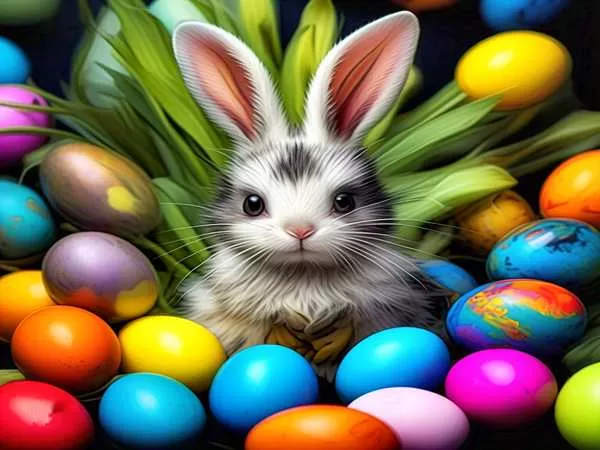Easter’s origins have sparked debates and theories that swirl with myth, historical tidbits, and speculation. While some claim it’s a Christian holiday adapted from ancient pagan practices, much of this narrative centers on a single mention from the 8th-century monk, the Venerable Bede, in his work De ratione temporum (The Reckoning of Time). Bede’s passing reference to a goddess named Eostre has fueled centuries of speculation, leading many to believe that Easter is rooted in paganism. But is this tale as simple as it seems?
The Venerable Bede and the Eostre Myth
In his book, Bede mentions that “Eosturmonath,” or the month of April, was named after a goddess called Eostre, in whose honor feasts were celebrated. However, this single line is the only ancient record of Eostre’s existence. There are no myths, temples, or other writings that solidly link Eostre to Easter celebrations. Based on Bede’s account, along with a scattering of place names and some Germanic inscriptions, many have concluded that Eostre’s festival was later adopted and rebranded as Easter by early Christians, much like other Christian holidays with pagan roots.
Jacob Grimm, of the famous Brothers Grimm, expanded on this idea in the 19th century. He linked Eostre to Ostara, a potential Old High German goddess of spring, with possible connections to the Greek goddess Eos, the dawn. This theory snowballed, with various scholars finding connections to deities across Germanic, Anglo-Saxon, Slavic, and Indo-European mythologies. However, these links remain speculative, with little concrete evidence to support them.
Rites of Spring: Rebirth and Renewal
Despite the ambiguity surrounding Eostre, the rites of spring were already a time of rebirth and renewal, themes that resonate deeply with Easter’s symbolism. The Easter egg, a widely recognized symbol of rebirth, existed long before the advent of chocolate eggs. Across Europe, people would dye and decorate eggs, presenting them as gifts. This tradition aligns with the abundance of eggs at Easter, which had accumulated during Lent, a time when Catholics abstained from eating them.
The connection between hares, rabbits, and Easter also has deep roots. Hares, often associated with fertility due to their prolific breeding, were linked to the Virgin Mary in medieval Christian symbolism. The hare was seen as an animal of dual nature—fertile yet elusive, linking it with ideas of purity and rebirth. Over time, hares became intertwined with various myths and legends, and their image morphed into the familiar Easter Bunny.
The Mad March Hare and Folklore Connections
Hares have long held a place in folklore as mystical creatures. They are famously depicted “boxing” in the fields during spring—a behavior now known to be females fending off males rather than males fighting over mates, as once thought. This behavior cemented the Mad March Hare as a herald of spring.
Hares also appear in literature, like Lewis Carroll’s Alice in Wonderland, where the March Hare epitomizes spring madness. In mythology, hares were considered companions of Aphrodite, the goddess of love, and were associated with Luxuria, the personification of lust. As the stories evolved, the hare became a rabbit, and then a bunny—a softer, cuddlier version that fit nicely into the Easter narrative.
Pagan Roots or Christian Symbolism?
The notion that Easter is a purely pagan holiday repurposed by Christians oversimplifies the evolution of the celebration. While elements like eggs and hares have clear pagan connections, the Christian significance of Easter—marking the resurrection of Jesus Christ—has been central to the holiday since its inception. The symbolic blend of old and new was a way to resonate with newly converted Christian populations without discarding their established traditions entirely.
Curious Connections: Hermaphroditic Hares and Ancient Myths
The association between hares and fertility went beyond folklore. Pliny the Elder, the Roman historian, wrote about the hare’s peculiar reproductive habits in his Naturalis Historia, claiming they could reproduce without a mate. This led to the hare being viewed as a hermaphroditic creature, able to embody both sexes, and adding another layer to its association with fertility.
Even more curious is the tale of Salmacis, a naiad from Greek mythology who merged with the youth Hermaphroditus, creating a being of both male and female traits. This legend gave us the term “hermaphrodite,” a concept that extended to creatures like the hare in ancient interpretations. The connection between these ancient myths and symbols showcases how interconnected the ideas of fertility, transformation, and renewal have been throughout history.
The Ever-Evolving Symbolism of Easter
The rich tapestry of Easter’s origins reveals a complex blend of myth, tradition, and religious symbolism. From Bede’s brief mention of Eostre to the transformation of hares into Easter bunnies, the celebration of Easter has adapted over centuries, absorbing diverse elements from various cultures. Whether you view Easter as a Christian holiday, a remnant of pagan rites, or a mix of both, its themes of rebirth and renewal resonate universally. The symbols we cherish today—eggs, bunnies, and the bright promise of spring—remain timeless reminders of the season’s enduring power.

